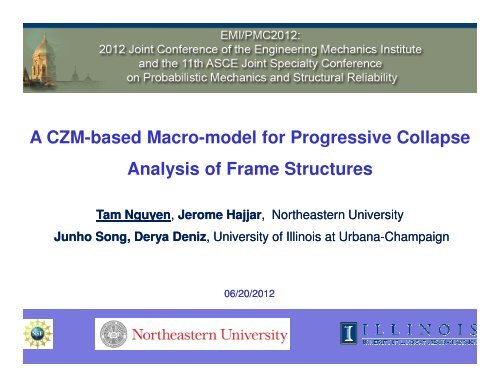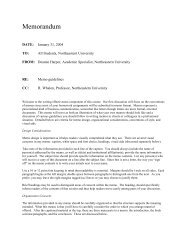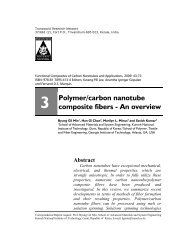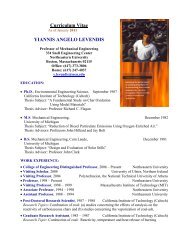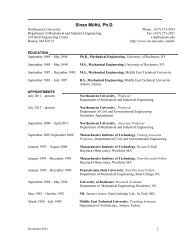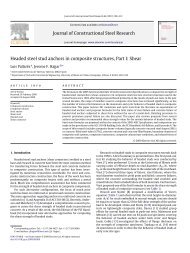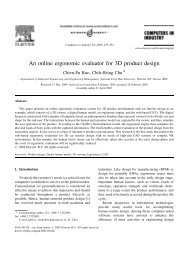presentation - Northeastern University
presentation - Northeastern University
presentation - Northeastern University
You also want an ePaper? Increase the reach of your titles
YUMPU automatically turns print PDFs into web optimized ePapers that Google loves.
A CZM-based Macro-model for Progressive Collapse<br />
1<br />
Analysis of Frame Structures<br />
Tam Nguyen Nguyen, , Jerome Hajjar Hajjar, , <strong>Northeastern</strong> <strong>University</strong><br />
Junho Song, Derya Deniz Deniz, , <strong>University</strong> of Illinois at Urbana Urbana-Champaign Champaign<br />
06/20/2012
2<br />
1. Background Progressive Collapse<br />
2. Cohesive Zone Model<br />
Content<br />
3. CZM-based Macro-model<br />
4. Summary
3<br />
Key elements of structural analysis and practice<br />
� Collapse assessment of new and existing seismicresisting<br />
systems: Incremental dynamic analysis<br />
(IDA) for ATC-63 to access collapse prevention of<br />
structural systems in seismic zone.<br />
Incremental dynamic analysis (IDA) of a 5story<br />
steel braced frame for 30 records by<br />
Vamvatsikos and Cornell, 2002<br />
An Integrated Platform for Validated Prediction of Collapse of Structures
4<br />
Key elements of structural analysis and practice<br />
� Regional loss assessment to prevent large-scale<br />
disaster: Fragility curve development for regional<br />
loss assessment (Mid-America Earthquake<br />
Center, MAEviz)<br />
�� Collapse prevention in U.S building codes:<br />
Structural integrity provisions in the wake of 9-<br />
11, whereby it is difficult to ascertain the impact of<br />
provisions because we have inadequate capacity as<br />
a profession to model collapse<br />
An Integrated Platform for Validated Prediction of Collapse of Structures
5<br />
Existing approaches for collapse modeling<br />
Continuum FEM<br />
� Indirect model fracture by “delete element”<br />
� Khandelwal and El-Tawil (2007): shell elements + Gurson model<br />
� Xu and Ellingwood (2011) brick elements + J2 plasticity<br />
Khandelwal and El-Tawil (2007)<br />
Xu and Ellingwood (2011)
6<br />
Existing approaches for collapse modeling<br />
Macro-model FEM<br />
� Fracture using spring elements / critical plastic strain -> “delete element”<br />
� Kanvinde (2003), Rodgers and Mahin (2006), Lee and Foutch (2004)<br />
� Khandelwal et al. (2008), Fu (2009), Szyniszewski (2012)<br />
� Concentrated plasticity: Kaewkulchai and Williamson (2004)<br />
spring model Khandelwal et al. (2008)<br />
Rodgers and Mahin (2006)
7<br />
Existing approaches for collapse modeling<br />
Applied Element Method (AEM)<br />
� Elements are connected through nonlinear springs<br />
� AEM: modeling crack initiation, propagation, fracture<br />
� Meguro (2003), Meguro and Tegel-din (2006)<br />
� Challenging to model ductile materials: e.g. Poisson’s ratio effect<br />
Modeling of structure in AEM<br />
AEM element separation<br />
http://www.appliedelementmethod.org
8<br />
Existing approaches for collapse modeling<br />
Adaptive shifted integration (ASI) method<br />
� Isobe and Toi (2000), Natahira et al (2008)<br />
� Physical equivalent of a linear Timoshenko beam and rigid bars<br />
connected via rotational spring<br />
� Proposed to shift the integration point in a beam element depending<br />
on the stage of plasticity/facture to handle strong discontinuity in<br />
progressive collapse analysis<br />
Linear Timoshenko beam<br />
and its physical equivalent<br />
Natahira et al (2008)
9<br />
Scope of research<br />
This research seeks “to create” effective and practical<br />
computational formulations for collapse modeling of<br />
steel structures<br />
� CZM continuum model + CZM-based macro-model<br />
formulations for structural collapse (<strong>Northeastern</strong><br />
Uni.)<br />
� A stochastic framework to identify accurate collapse<br />
limit states and critical damage measures via<br />
incremental dynamic analysis (UIUC)
10<br />
Collapse of industrial structure<br />
(Midwest Steel, Inc 2008)<br />
Cohesive Zone Model<br />
Collapse of structure vs. fracture failure using CZM: elements are<br />
disassociated<br />
CZM “has mainly been applied” to brittle materials in continua.<br />
Limited CZM studies for ductile materials “on a structural scale”<br />
Develop CZM-based macro-model<br />
� Efficient<br />
� Cyclic loadings<br />
Fracture failure using Cohesive Zone Model<br />
(CZM) approach (Zhang, 2003)
11<br />
Cohesive law<br />
CZM schematics<br />
Intrinsic model<br />
Extrinsic model<br />
Cohesive Zone Model<br />
(Park, 2009)
12<br />
Cohesive Zone Model: ductile materials<br />
Scheider and Brocks (2003), Tvergaardand Hutchinson (1992), Needleman, A. (1987)<br />
Load Load-displacement displacement curve Cohesive law for loading<br />
Fracture surface<br />
Cohesive law for unloading
13<br />
CZM: PPR cohesive model<br />
Based on potential, fracture energy, mixed-mode (Park et al, 2009)<br />
Wide range of materials including brittle and ductile material<br />
Parameters α, β control the slope, allow<br />
model different materials<br />
tension<br />
shear
14<br />
PPR cohesive model implementation<br />
Explicit time integration scheme (Abaqus explicit)<br />
User element subroutine<br />
� Virtual work<br />
� Update displacement<br />
� Update acceleration<br />
� Update velocity<br />
Mesh generation<br />
� Meshing by Abaqus/CAE<br />
� Insert cohesive elements into the mesh
CZM for ductile materials<br />
�� Validate CZM for ductile material using coupon Test<br />
�� CZM using PPR PPR model (Park, 2009) 2009) for mixed mode fracture<br />
�� CZM elements are inserted in critical area<br />
�� Preliminary Preliminary CZM result shows good agreement with experiment CZM elements<br />
15<br />
(tests at UIUC)<br />
Force (KN)<br />
60<br />
50<br />
40<br />
30<br />
20<br />
10<br />
0<br />
Buck elements<br />
1/4" Test Number 1<br />
experiment<br />
analysis<br />
0 10 20 30 40 50 60<br />
Displacement (mm)<br />
Simulation vs. Experiment<br />
Exp
16<br />
CZM for progressive collapse (3D)<br />
�� CZM using PPR PPR model (park, (park, 2009) for mixed mode fracture<br />
�� CZM elements are inserted in critical areas<br />
�� Abaqus explicit + user element<br />
Park (2009)<br />
PPR CZM model<br />
Insert cohesive<br />
elements<br />
continuum elements<br />
elements Khandelwal and El-Tawil (2007)
N<br />
17<br />
A CZM-based macro-model<br />
1 3 3 4 4 2<br />
M<br />
h<br />
3 4<br />
Fiber section<br />
M<br />
The beam element B34 can<br />
be modeled in the same<br />
manner as CZM in<br />
continuum model<br />
N<br />
fiber<br />
δ<br />
Section<br />
Fiber section will follow<br />
modified plasticity model<br />
The stiffness of the fiber<br />
will be degraded (Damage<br />
parameter K = K 0*D)
Modified Multi-surface Kinematic Hardening Plasticity<br />
18<br />
K = K 0*D)<br />
The multi-surface kinematic hardening plasticity model (Mroz 1967) is<br />
modified for the fiber of the CZM-based macro-model to model cyclic<br />
loadings, softening and fracture<br />
n – line segments of constant tangent modulii: E 1, E 2, E 3,.., E n<br />
f 0, f 1, f 2 ,…, f n are hyper-surfaces with constant hardening modulii. All surfaces<br />
can translate in space without changing form and orientation<br />
- Loading/unloading ���� cyclic
Modified Multi-surface Kinematic Hardening Plasticity<br />
19<br />
Cantilever example<br />
Applied load<br />
Top displacement<br />
(Danevit, Opensees) vs. (macro-model)<br />
Elastic -plastic<br />
Applied load<br />
elastic
20<br />
Collapse modeling using CZM-based macro model<br />
Kanvinde (2003):<br />
Analyze using the proposed<br />
CZM-based macro-model<br />
2 3<br />
1<br />
Interface element<br />
spring model<br />
beam<br />
4
21<br />
Progressive collapse<br />
� Aim to develop a robust and efficient procedure<br />
Cohesive Zone model<br />
� Continuum mechanics<br />
� Fracture modeling<br />
CZM-based macro model<br />
� Fiber-section, efficient<br />
Summary<br />
� Multi-surface kinematic hardening plasticity<br />
� Cyclic and fracture


